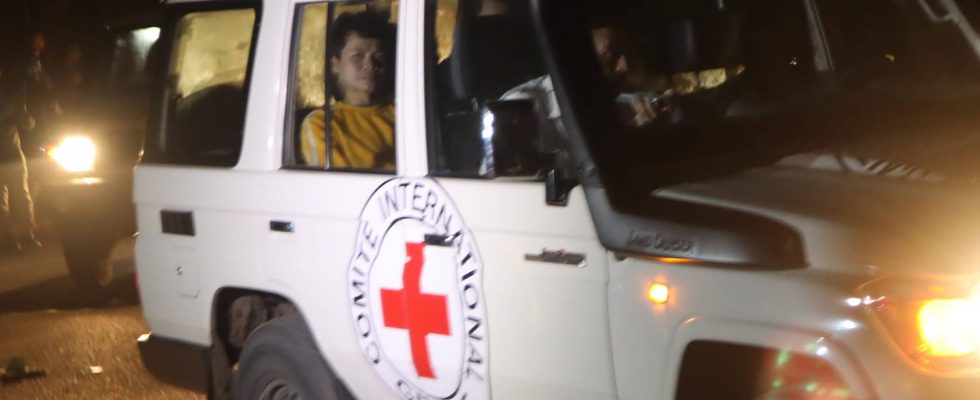Dozens of hostages, including three French people, were released during the truce between Hamas and Israel. The first testimonies on the conditions in which they were held are beginning to be revealed.
With the release of the hostages, the veil is gradually lifted on their conditions of detention in Hamas bases. More than 60 hostages – 43 Israelis and 26 foreigners or dual nationals including three with French nationality – and 12 Thai workers were freed during the first four days of the temporary humanitarian truce between Hamas and Israel, and others are expected to follow. But still more than 150 hostages are being held for the Palestinian Islamist group and awaiting release without having any guarantees.
The released hostages are beginning to open up about their more than 40 or 50 days of detention. The Israeli army is careful not to leak any information, but some testimonies have reached the media. They all report a “hell” and the “horrors” experienced by the hostages. “It’s unimaginable,” said the aunt of one of the three Franco-Israeli teenagers released on November 27 after having found their daily lives in the hands of Hamas.
Hostages abused and mistreated?
Of the dozens of released hostages, few showed serious physical injuries. The hostages “were not tortured or mistreated” according to Meirav Raviv, relative of three hostages released by Hamas – her cousin, her nephew and her grandmother – with Ynet. But other testimonies report scenes of beatings during the arrival of the hostages in Gaza, such as that of Deborah Cohen, the aunt of the Franco-Israeli Eitan released on November 27, on BFMTV. “Apparently Eitan was not treated well” according to the aunt and the boy’s mother adds RTL. Of all the hostages released, only one was hospitalized in intensive care upon arrival in Israel “due to a serious lack of care during her detention” according to the director of Soroka Hospital in Beer Sheva, in the south of Israel.
Uncertainty therefore still hovers over the physical violence suffered by the hostages during captivity, but all suffered from the conditions of detention. Several relatives of hostages indicated that they had found their family members thinner, some having lost 7 kilos as indicated by Meirav Raviv. “There were days when they had no food,” she assures. And when there were meals, they were meager mainly composed of bread or rice, cheese and cucumbers according to Yocheved Lifshitz, an octogenarian Israeli released on October 23, before the agreement between Israel and Hamas. Very irregular meals and also limited access to hygiene: “We had to wait an hour and a half to two hours from the moment we asked to go to the toilet until they authorized it”, according to the testimony of Meirav Raviv. However, octogenarian Yocheved Lifshitz explained after his release that the conditions of captivity showed a certain preparation since the jailers had provided “shampoo and conditioner”.
Threats and “mental torture” against the hostages
However, there is no doubt about the psychological violence suffered by the hostages during their captivity. French teenager Eitan “experienced horrors” according to those close to him and was “forced to watch the film” of the October 7 attack, his mother said. The hostages were also threatened during their detention according to the same testimony: “Every time a child cried, they threatened him with a weapon.” Meirav Raviv also spoke of threats from jailers against the hostages and their families, according to her, some members of Hamas accompanied their threats with gestures mimicking a slitting of the throat.
“The children really went through hell. They suffered mental torture, very, very hard experiences,” indicated the families of the two other freed French children, the brothers and sisters Erez and Sahar Kalderon, at Parisian.
Where were the hostages held?
The hostages captured during the October 7 attack would not be grouped in the same place according to information from the Israeli army and in recent days specialists have reported in the Israeli media that the hostages could be distributed and held by different formations such as Hamas, Islamic Jihad and other rebel groups. The hostages would therefore be scattered across the north of the Gaza Strip and would not all be held in the same conditions. But all appear to be held underground, and perhaps in tunnels used by Hamas according to Israeli army intelligence. Yocheved Lifshitz explicitly indicated that she found herself in a tunnel spread like “a spider’s web” underground and a relative of another released hostage told the Times of Israel that the latter had “had to adapt to the sunlight” and “walked with her eyes down because she was in a tunnel”. Testimonies shared by other relatives of released hostages.
